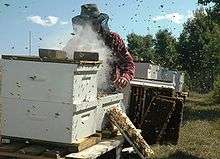John Hampson (artist)
John Hampson was an artist whose works hang at the Fairbanks Museum in Vermont. Hampson is known for his unusual mosaics formed of tens of thousands of insects, whether moths, butterflies, or beetles.
Life
Hampson was born in Stockport, Cheshire, England on July 9, 1836.[1] He trained as a machinist[2] and came to the United States in 1860. During the Civil War he worked in the government navy yards, after which he subsequently moved to thirteen different states. In 1877, he settled with his wife in Newark, New Jersey.[2][1] He worked briefly for Thomas Edison in his Menlo Park laboratory.[3]
Hampson's passion for insects[4] inspired him to create at least nine[5] mosaics made of moths, butterflies, and beetles arranged in designs.[6] Each piece, taking a few years to construct,[5][7] includes between 6,300 and 13,500 insects and each has a decorated frame that he constructed as well.[5] His designs included portraits of Abraham Lincoln and George Washington,[8] and one in which he celebrated his own 50th birthday.[7]
Exhibition
When Hampson died, his daughter searched for a museum that would exhibit his art, finding the Fairbanks Museum, in St. Johnsbury, Vermont,[9] was the Seven of the works are on display at the museum; three collages, General Slocum (of Henry Warner Slocum), a portrait of George Washington, and a kaleidoscopic design are considered too damaged to exhibit.[2]
Descriptions of Hampson's work
The Newark News[5] stated "It would take perhaps three or four years for Hampson to complete one picture, mounting the insects so that the white, black, red, orange, blue and yellow wings would form pictures of famous American generals in characteristic poses, or intricate designs such as the North Star, completed in 1887, or the Centennial Wheel, finished in 1892, copies from patchwork quilts, which had won prizes at exhibitions."[1]
The website Roadside America described his work as "delicate interweaving of wings and metallic sheen of beetle carapace", and considered that Hampson had had "the misfortune of being born a hundred years too soon", speculating that had he lived now he might have been celebrated for building a "chapel on a 'Bug Mountain'".[7]
Atlas Obscura considered the mosaics "the stars of Fairbanks' collections", finding them "absolutely jaw-dropping in person."[10]
References
- 1 2 3 "Bug Art". Fairbanks Museum. Retrieved 1 March 2017.
- 1 2 3 Samels, Zoe (2012). "Pinning Down History | Insects, America, and the Art of John Hampson" (PDF). Art Conservator. Williamstown Art. pp. 12–15. Retrieved 1 March 2017.
- ↑ Citro, Joseph A. Citro; Foulds, Diane E. (2004). Curious New England: The Unconventional Traveler's Guide to Eccentric Destinations. UPNE. pp. 310–. ISBN 978-1-58465-359-2.
- ↑ Benson, Sara (2010). USA's Best Trips: 99 Themed Itineraries Across America. Lonely Planet. p. 201. ISBN 978-1-74179-735-0.
- 1 2 3 4 Gillis, Anna Marie. "Best Bug Art Ever". National Endowment for the Humanities. Retrieved 1 March 2017.
- ↑ McQuillen, Charles. "Medium a Month: Dead Bugs". McQuillen Studios. Retrieved 1 March 2017.
- 1 2 3 "Bug Art Of John Hampson". Roadside America. Retrieved 1 March 2017.
- ↑ Bushnell, Mark (May 14, 1995). "Museum Preserves Another Time". The Burlington Free Press. p. 77. Retrieved 2 April 2018.
- ↑ Goska, Dave (August 13, 1978). "An Artful Display of Bugs in St. Johnsbury". The Burlington Free Press. Retrieved 2 April 2018.
- ↑ Enemark, Michelle (23 July 2013). "Notes from the Field: From Tombstone Quarry to Natural History in Northern Vermont". Atlas Obscura. Retrieved 30 March 2018.
